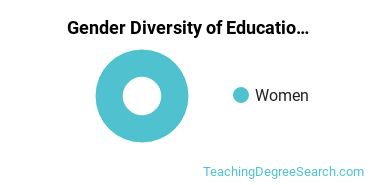Education at Keweenaw Bay Ojibwa Community College
KBOCC is located in Baraga, Michigan and has a total student population of 79.
Want to know more about the career opportunities in this field? Check out the Careers in Education section at the bottom of this page.
KBOCC Education Degrees Available
- Associate’s Degree in Education
KBOCC Education Rankings
Education Student Demographics at KBOCC
Take a look at the following statistics related to the make-up of the education majors at Keweenaw Bay Ojibwa Community College.
KBOCC Education Associate’s Program

The following table and chart show the race/ethnicity for students who recently graduated from Keweenaw Bay Ojibwa Community College with a associate's in education.

| Race/Ethnicity | Number of Students |
|---|---|
| Asian | 0 |
| Black or African American | 0 |
| Hispanic or Latino | 0 |
| White | 1 |
| International Students | 0 |
| Other Races/Ethnicities | 0 |
Concentrations Within Education
If you plan to be a education major, you may want to focus your studies on one of the following concentrations. The completion numbers here include all graduates who receive any type of degree in this field from Keweenaw Bay Ojibwa Community College. Some of these focus areas may not be available for your degree level.
| Concentration | Annual Degrees Awarded |
|---|---|
| Teacher Education Grade Specific | 1 |
Careers That Education Grads May Go Into
A degree in education can lead to the following careers. Since job numbers and average salaries can vary by geographic location, we have only included the numbers for MI, the home state for Keweenaw Bay Ojibwa Community College.
| Occupation | Jobs in MI | Average Salary in MI |
|---|---|---|
| Elementary School Teachers | 38,330 | $66,180 |
| Teacher Assistants | 35,700 | $27,570 |
| High School Teachers | 24,130 | $62,950 |
| Middle School Teachers | 12,750 | $64,540 |
| Preschool Teachers | 9,270 | $35,010 |
References
*The racial-ethnic minorities count is calculated by taking the total number of students and subtracting white students, international students, and students whose race/ethnicity was unknown. This number is then divided by the total number of students at the school to obtain the racial-ethnic minorities percentage.
More about our data sources and methodologies.
